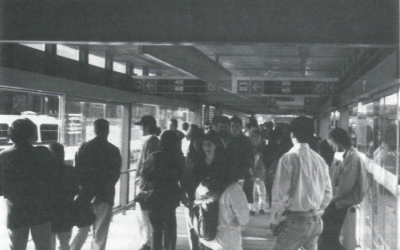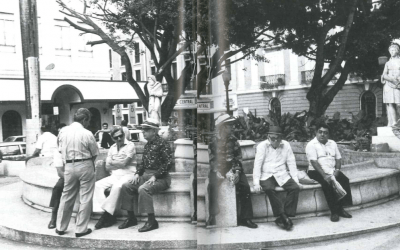Low-Income Housing in El Salvador
El Salvador’s tremendous housing deficit had slowly begun to improve in the late 1990s. Then devastating twin earthquakes in early 2001 literally shook the country’s economic and social foundations. Three years before the earthquakes, the housing shortage still exceeded half a million units in 1999, and homes were becoming increasingly available. According to official documents, for instance, the national proportion of formal sector dwellings had increased from 40.14% to 64.50% from 1971 to 1993. Homeownership indicators had also showed significant improvements: in 1971, 29% of households owned their dwellings, 15% had mortgages and 41% rented. Whereas 41% of households owned their dwellings, 28% had mortgages and 23% rented some form of housing in 1992.
Indeed, El Salvador was surpassing other countries in the region because of improvements in the quality of building materials and provision of services. Households with monthly incomes of $500-$600, for instance, now had access to credit and could purchase a commercially produced house by borrowing from the banking system. Whereas only 10% of Mexican households and 12% of Guatemalan houses could garner commercial financing, 23% of households in El Salvador had such an opportunity.
Such achievements were remarkable, considering that they had taken place against the backdrop of a 12-year armed conflict (1980-1992) that killed 75,000 people and displaced one million, an earthquake (1986) that left an estimated 9,000 families without shelter in the city of San Salvador alone, and Hurricane Mitch (1999) that left 59,000 residents homeless. The effects of these disasters, combined with high levels of poverty, had resigned the country to a 114th-place ranking in the worldwide Human Development Index in 1999.
El Salvador’s housing success was largely the result of its nation-wide industry of private developers supplying legal, low-cost subdivisions at very large scales. Some 200 firms were reported to be active and they accounted for 50% to 70% of the annual growth in housing for low-income households. These residential enclaves or urbanizaciones became my topic of research during my course of studies at the Harvard Design School.
My feelings about urbanizaciones were mixed. On one hand I was uneasy about their unprecedented scale, the uniformity of the houses, the rigidity of their layouts, and the arid and foreign environments that they were creating. On the other hand, I couldn’t help but acknowledge that the houses in these privately built developments were cost effective and represented an improvement for many families who had previously lived in substandard homes.
Setting off on a three-year study of urbanizaciones, however, I began to notice that the parts of the city where a large number of urbanizaciones were concentrated were also the parts of the city that other residents considered most dangerous. Crime and violence in El Salvador had reached alarming levels; newspaper articles and public opinion polls frequently reported that most Salvadorans were first and foremost concerned about crime. Experts and newspaper columnists usually blamed crime on poverty, unemployment and lack of opportunities. But although San Salvador has zones or urban pockets where these social ills were more common than in urbanizaciones, people I talked with many people who expressed less concern about their personal safety when passing through those areas than when traveling through areas where large numbers of urbanizaciones existed. If lower incomes, unemployment and fewer opportunities were causing higher crime rates, why were the urbanizaciones—whose residents could be considered upwardly mobile low-income families—perceived to be so dangerous?
Given my long-running interest in the way physical space affects people, I began to wonder whether there was a link between the real or perceived higher levels of crime and violence in these areas and their physical characteristics. I contemplated doing a study relating physical space to violence but a summer-long reconnaissance spent in El Salvador deterred me from such a project. While in the field, I encountered problems obtaining relevant data, and I realized that time constraints and safety considerations would prevent me from conducting the larger-scale, random sample interviews and questionnaires that a rigorous scientific study would require. Instead, I favored a more limited set of in-depth interviews to explore the thoughts of residents of urbanizaciones about their physical surroundings and their neighborhoods in general, while keeping an open mind and avoiding questions specifically related to crime and violence.
This type of study required an alternative form of housing to compare to urbanizaciones. I soon learned that in El Salvador, unlike in the rest of the region, a category of “progressive” sub-divisions could be approved before any infrastructure investment. As a result, there was a legal market for plots that cost between $700 and $1,400, depending on location. Furthermore, the developers themselves provided 8-12 year loans to purchasers, who made monthly payments of $15-$25. Thus, conflictive land invasions were rare and the importance of inner city tenements had largely been reduced. These progressive sub-divisions—called lotificaciones—were quite distinct from those of urbanizaciones and hence seemed like good counterparts. In addition, I included a third category of legalized and retrofitted land invasions, which I referred to as comunidades. Urbanizaciones, lotificaciones and comunidades essentially represented three categories of low-income home-owning families: upper-low-income, middle-low-income and lower-low-income respectively.
I spent three consecutive summers handing out questionnaires and conducting at-length unstructured personal interviews. The results were unexpected. People were eager to discuss crime and violence, especially that caused by youth gangs in their midst. Those more likely to complain about their physical surroundings and about their quality of life in general were residents of urbanizaciones.
My research suggested that well-intentioned housing policies might have produced these unintended consequences. For instance, special government-backed mortgages that allowed for the purchase of a house in an urbanización required employment of the beneficiaries in the formal sector. For the most part, this meant jobs in factories and assembly plants. This type of employment caused most adult residents to be absent from their neighborhoods for extended periods of time every day. This resulted in large numbers of children and teenagers that were left unsupervised.
The desire for efficiency in terms of engineering and economics had lead to the construction of urbanizaciones on the outskirts of cities. The sizable distances from residents’ places of employment resulted in long commutes to and from work and less time spent in the neighborhoods. Homes were designed for smaller nuclear or single-parent families. The more traditional structure of the extended family—which allows grandmothers and aunts and other adults to supervise the young at home—could not be easily accommodated. Houses could not be easily adapted for home-based businesses—a source of passive street surveillance. Even factors such as heat-conducive building materials and the absence or the unsuitable location of social infrastructure pushed the young outside the house and farther from sight of responsible adults.
Moreover, urbanizaciones presented lower levels of social capital among their residents than their two counterparts. Their residents were tied to financial obligations and a certain lifestyle that did not leave them much time to spend with their neighbors. So residents of urbanizaciones, although generally in a higher socio-economic category than the other two categories, seemed less content with their quality of life. At the other extreme, in comunidades, safety issues were the worst among the three neighborhoods studied. But in that case, residents’ needs were still at the basic level of physiological requirements, so safety considerations and quality of life issues were not mentioned. They mostly complained about lack of employment. Jobs were necessary to satisfy their fundamental necessities such as food, health, and decent shelter.
Of the three groups, residents of lotificaciones seemed to be the ones who were most satisfied with their lives. The flexibility to adapt the houses according to their particular circumstances gave a sense of pride. The ability to build their own houses slowly, as financial resources permitted, without the pressures of a long-term loan, provided them with a greater sense of achievement, less stress and stronger ties to their communities. In the end, a sense of belonging outweighed economics and politics.
Graciela Fortin-Magaña is a native of El Salvador, an architect and a recent graduate of the Harvard Graduate School of Design where she received the degrees of Doctor of Design and Master of Design Studies. Professors Ed Robbins and Tony Gomez-Ibañez guided her in this study.
Related Articles
Bogotá: A City (Almost) Transformed
The sleek red bus zooms out of the station in northern Bogota, a futuristic symbol of an (almost) transformed city. Nearby, thousands of cyclists of all ages enjoy a sunny morning on Latin America’s largest bike-path network.
Editor’s Letter: Cityscapes
I have to confess. I fell passionately, madly, in love at first sight. I was standing on the edge of Bogotá’s National Park, breathing in the rain-washed air laden with the heavy fragrance of eucalyptus trees. I looked up towards the mountains over the red-tiled roofs. And then it happened.
Social Spaces in San Juan
My city, San Juan, is a social city. Its character and virtue are best illustrated and defined by the collective and individual memories of its people and those places where we go to spend time in idleness….




